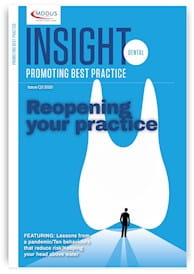
“Hello, it’s been a while since I’ve seen you.”
This sentence is likely to feature heavily at dental appointments for some time. But what are the implications for patients who may have had to deal with painful conditions for much longer than usual?
The option to ‘self-medicate’ or seek prescribed medication to manage pain is likely to have been taken by many and the chances of opioid-based painkillers or high doses of paracetamol being used for longer and at higher doses than recommended seems very high. Research prior to the COVID crisis indicated that dental pain was a regular factor in hospital admissions for paracetamol overdoses.
Combined with these specific risks to dental patients, we know these drugs are often misused to cope with stress, and we have just been through a period where ‘business as usual’, particularly in terms of appointments and regular reviews, has been severely disrupted.
We also know that prescribing levels for these drugs tend to be higher in areas of greater deprivation and among communities likely to be most impacted economically by the coming recession. We could be facing a perfect storm of risk.
As director of innovation and service delivery at Agencia, I’ve worked closely with healthcare professionals on a number of projects related to managing alcohol and drug misuse. Agencia operates in partnership with government to deliver new policies and to help providers and commissioners improve frontline services to tackle opioid dependence.
In this article I want to share my experience in designing and running ReWire, a project in North Lincolnshire which worked with patients at high risk of opioid dependence. Many of the insights gained are highly relevant to dental practice.
The ReWire approach
Research had identified opioid analgesic dependence (OAD) as a significant health risk to the population. Agencia worked with North Lincolnshire Council and a number of GP practices to identify the scale of the problem and develop workable and scalable solutions – and from this pilot the ReWire service evolved. It sought to address the issue through analysis of prescribing data, patient identification via an opioid risk assessment tool (ORAT), and provision of a service which combines a non-medical prescribing pharmacist and an experienced psychosocial worker to support individuals who wish to address their OAD.
We ran ORAT (a validated diagnostic support tool) across a selection of medical practices which reflected the demographics of North Lincolnshire, and we filtered the results to include only under 55s and those identified as potentially most at risk. Of those engaged in treatment, 44 per cent were female. The results were assessed consistently by an experienced pharmacist with clinical support from GPs. Patients identified as being potentially at risk were then invited by GPs to attend for a medication review, with immediate support available from an experienced psychosocial worker who could offer a six-session programme which covered interventions from brief advice through to full opioid substitution therapy (OST).
We focused on practical solutions, supported by lots of informal awareness-raising – leaflet drops and training the GP admin and reception teams on how to work with a group of patients who were nervous about being called in for a review and managing those anxieties sympathetically. The aim was to inform first, and then engage. Our engagement, treatment and session models recognised this patient group would not feel comfortable in a ‘drug service’.
The results were surprising. A group of patients who were seen as potentially very resistant to change proved to be very open to new approaches to pain management and often expressed private concern about the amount of medication they were taking and its impact on their quality of life. Many changed their prescribing regimes, with 20 per cent of patients stopping repeat prescribing on receipt of a first letter. Even those who required OST usually swiftly became drug-free.
Many of the patients we engaged had a series of longer conversations with our clinicians, pharmacists and psycho-social workers and we were able to establish some fascinating insights into how and why they started using opioid painkillers. Some left hospital with ongoing prescriptions to manage pain and were then maintained on those prescriptions, often with increased doses over a period of time. Many were not aware of the long-term risks of opioid prescribing and they also had little knowledge of alternative ways of managing pain.
Again, by spending time with them discussing how they dealt with pain and introducing them to alternative methods of coping (such as using a pain management toolkit), we were often able to improve outcomes. Another factor in long-term use of painkillers was that many mistook relatively mild withdrawal symptoms for a return of their pain and, after a short session on how to manage these withdrawals, were able to cope far better and often taper their prescriptions. Patients and their families genuinely appreciated the intervention.
What helps?
There is no easy solution to painkiller misuse, particularly in the current challenging circumstances. Dental patients often need pain relief for a period of time after their treatment. There are a number of techniques and proactive practices that could make a significant difference:
- Discuss with patients their pain management in the period running up to the appointment, particularly if you are aware of a long delay. Most patients expect to be asked about wider health and behavioural issues by healthcare professionals so do not feel this is inappropriate.
- Investigate use of over-the-counter (OTC) medication. We found that a significant number of patients requiring formal addiction treatment for opioid painkiller misuse had started on OTC medication. We had one patient who had started self-medication for dental pain who had attended at least three outpatient appointments and a couple of emergency admissions for gastric problems without mentioning that he was taking significant amounts of co-codamol and had been for years. When challenged, he said: “No one asked me about that”.
- Point out the long-term risks and also make clear what short-term withdrawal feels like, along with some coping strategies.
- Produce easily accessible patient information leaflets. The information that comes with the medication is rarely easy to understand and is almost always in very “small print”.
- Be aware what resources are available to help patients who admit they may have a problem. Our work indicated that there is a lack of services specifically helping this patient group, but their GP should be a good starting point.
- Do your utmost to de-stigmatise the issue. A sympathetic approach could be life-saving.
Spotting potential addiction
None of this is easy and, in a high-pressure environment, finding time can be difficult. But in our experience, a small amount of prevention can have a huge and positive impact on patient outcomes.
I have also run programmes at a number of dentist practices to help identify and support those facing a range of health issues, including smoking, alcohol misuse and unhealthy eating, called Making Every Contact Count (MECC). We had great results through finding champions, often dental assistants, to take the lead in designing prevention and information services. I believe that this model could be highly effective without requiring too much in the way of service redesign or resources.
Conclusion
ReWire was created to use data intelligently to target those most at risk of addiction and focus on prevention. We have found it is possible to significantly reduce prescribing costs and improve patient outcomes. It has also given us real insight into patients struggling with painkiller use.
In the course of running this programme based on medical conditions, we would extrapolate those findings to suggest that pain from dental conditions, particularly combined with limited treatment options in deprived communities and ‘fear’ of dental treatment, could be a route into significant painkiller misuse. Often just ‘asking the question’ is enough to change the outcome for patients.
Graeme Dixon is director of service and innovation at Agencia, where he has run a number of services identifying and managing opioid addiction in partnership with GP practices
- Find out more about Agencia and ReWire at www.agencialtd.com
- Follow them on Twitter @agencia_ltd, and @ReWirePKService
This page was correct at the time of publication. Any guidance is intended as general guidance for members only. If you are a member and need specific advice relating to your own circumstances, please contact one of our advisers.
Read more from this issue of Insight Dental

Save this article
Save this article to a list of favourite articles which members can access in their account.
Save to library